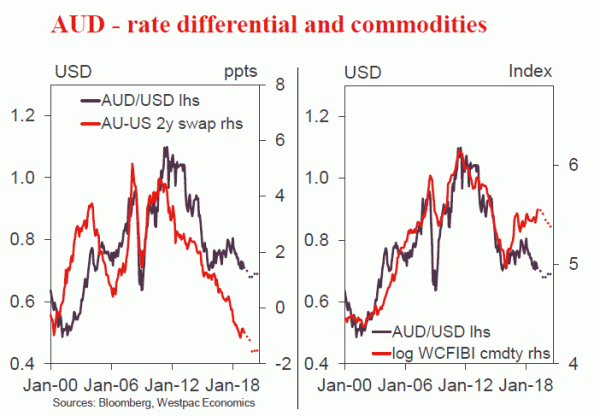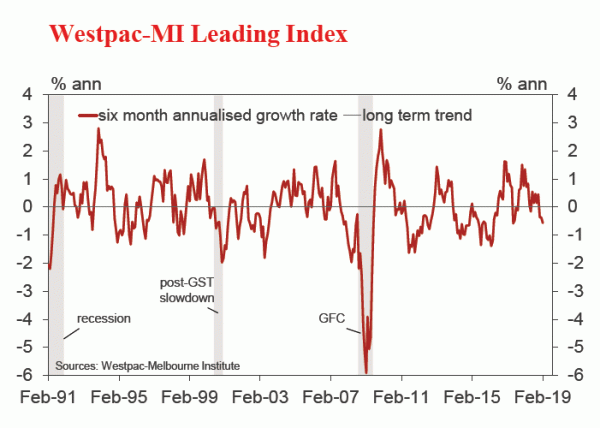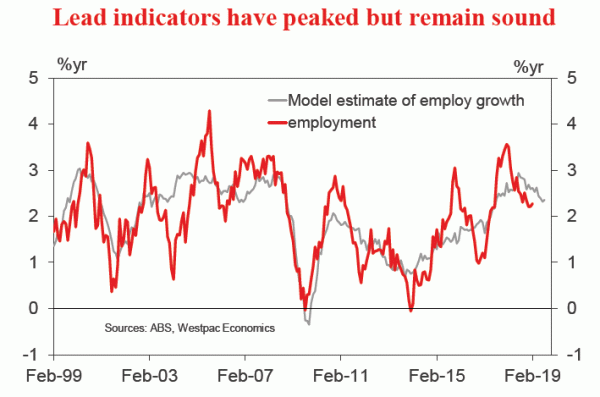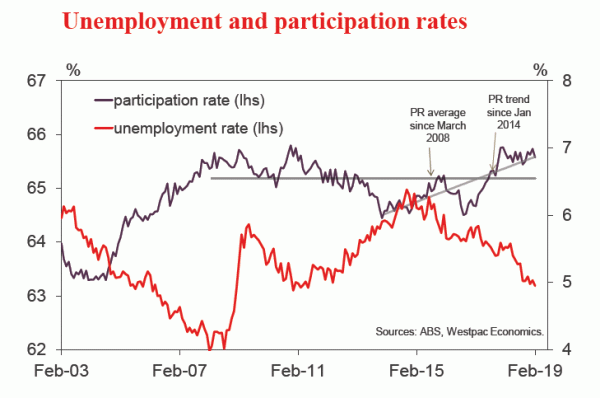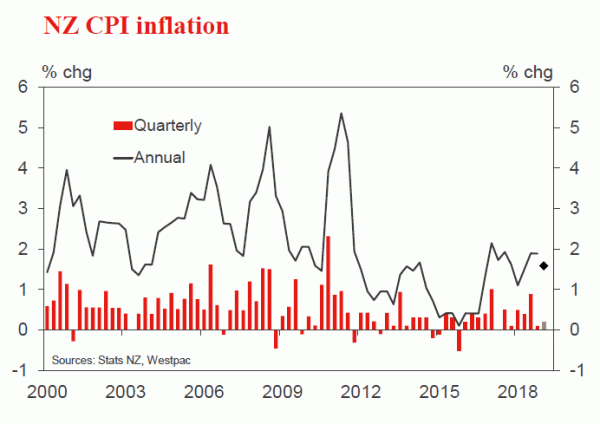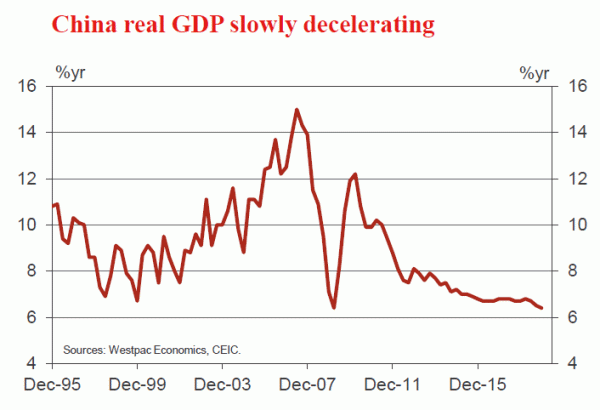Week beginning 15 April 2019
- The AUD, the RBA, the FOMC and commodities.
- Australia: Westpac-MI Leading Index, employment, RBA minutes, Good Friday.
- NZ: CPI.
- China: GDP, retail sales, industrial production, fixed asset investment.
- Europe: trade balance, ZEW survey.
- US: retail sales, industrial production.
- Flash PMI’s for Japan, the Euro Area, and the US.
- Key economic & financial forecasts.
Information contained in this report current as at 12 April 2019.
The AUD, the RBA, the FOMC and Commodities
The Australian dollar has held within a narrow range of USD0.704 to USD0.716 over the month.
Key commodity prices, particularly iron ore, have been stable over the month with spot at around US$90/t. General expectations have been for this price to adjust downwards. For example the government’s forecast for the iron ore price (fob) by March 2020 is US$55/t (Westpac expects US$74/t spot).
Supporting the iron ore price has been ongoing reports from Vale of likely decommissioning of supply following the collapse of the tailings dam in Brumadinho – general expectation is that Vale will decommission around 40t of production lowering overall annual production from 400Mt to 360Mt.
However markets are expecting even larger production cuts to eventuate. Another major producer, Rio Tinto, has also recently been impacted by a supply shock.
On the demand side, confidence is rising in response to China’s commitment to stabilising growth through lifting credit; easing restrictions on the shadow banking sector; supporting bond issues by local governments to finance new infrastructure investment; tax cuts; and some support to housing in selective regions.
This stability at high levels for key commodity prices is providing solid support to the Australian dollar – indeed the fair value of the AUD as measured by commodity prices, is currently holding well in excess of current spot.
On the other hand, interest rate differentials continue to weigh on the AUD. When on February 21, Westpac moved to forecast the RBA would cut the cash rate by 25bps in August and November this year, markets were not anticipating a cut until April next year.
That pricing has now moved forward to August/September with 75% of a second cut priced by mid next year. (pricing COB Wednesday).
However in a Q&A follow-up to a speech on Wednesday to the American Chamber of Commerce in Australia, Deputy Governor Debelle is reported to have noted “Our expectation is that we will see decent growth in the economy…so we won’t have to get to that point [of cutting rates].”
A test of that assertion will be when the RBA releases its revised growth; inflation and employment forecasts in the May Statement on Monetary Policy on 10 May. Currently, the RBA is forecasting GDP growth of 3% in 2019 and 2.75% in 2020. The lower growth rate in 2020 is largely explained by a reduced contribution from resource exports – particularly LNG.
Those forecasts were released for the February Statement on Monetary Policy when the RBA was forecasting growth of 2.75% for 2018. Subsequently, growth printed at 2.3% for 2018.
It would be very surprising if the RBA did not lower its growth forecasts at the time of the May update. (Westpac expects growth of 2.2% in both 2019 and 2020).With our view on the economy we would expect RBA forecasts of 2.5% and 2.25% (respectively).
Given Dr Debelle’s remarks, it is more likely that the RBA will choose 2.75% and 2.5%. But even those forecasts point to below potential growth in 2020. By May, the 2020 forecast is the most important one from a policy perspective given monetary policy acts with a lag.
The expected trigger for the rate cut would be a further downward revision in the growth forecasts at the August Statement on Monetary Policy to, possibly, 2.5% (2019) and 2.25% (2020).
Any central bank forecasting below potential growth should adopt an easing bias.
The recent change in the Governor’s Statement following the April Board meeting at least shifted the dial to a more flexible approach to policy rather than the sentiment which this Governor had maintained since his first Statement back in October 2016.
Despite the firming of the probabilities of a rate cut, the AUD has remained quite stable. That probably reflects the commodity environment and the limits to the forward expectations of currency markets.
The outlook for US interest rates is also important. In March markets had been pricing in a 70% probability of a rate cut from the FOMC by year’s end. That pricing has now moved back to a more reasonable 45% although pricing is around 80% for two cuts by September 2020.
Westpac has revised its outlook for the federal funds rate. We no longer expect a late cycle rate hike at the December meeting of the FOMC. My visit to the US in February gave me little confidence that the FOMC was likely to see the need to raise rates again in this cycle. Tailwinds in 2018, including those from global growth, fiscal policy, and financial conditions, have turned into headwinds in 2019.
Confidence around the ‘stickiness’ of the core PCE inflation measure was also clear. Indeed there was a general view that the FOMC needed to be seen to be symmetric around the 2% target for core PCE inflation. A period in which it ran above 2% would be welcomed in confirming that symmetric policy stance.
My concern has always been with the likely persistent lift in growth in hourly earnings (up from a 2.5% to a 3.2% annual growth rate over the last year) as the labour market remains buoyant. However there was a view that statistical research had failed to find a link between wages growth and core PCE inflation.
The concept of neutral rates had also been ‘adapted’. There was no longer a sense of ‘long term/short term’. Neutral policy depended on potential growth (around 2%) and core PCE inflation around 2%. Westpac’s, and the FOMC’s forecast for GDP growth in 2019 is around 2%, providing further comfort that rates could stay at current levels since they are now at neutral.
Equally we do not subscribe to the view that rates will be cut by the FOMC over the 2019 and 2020 time horizon. With lower mortgage rates; solid income growth; some expected upward pressure on inflation; and fiscal policy likely to be supportive, especially in the election year of 2020, a steady rate profile seems most likely.
With markets expecting rate cuts in the US and under-pricing rate cuts in Australia, some further downward pressure on the AUD can be expected from the current USD0.715. But with an improving commodity price outlook we have not moved our target of USD0.68 for AUD over the course of 2019 despite the flatter profile for the federal funds rate.
The week that was
The Federal election campaign officially kicked off in Australia this week shortly after the Westpac-MI consumer sentiment indicated the Budget was well received. Overseas, central banks reiterated a cautious tone while the Brexit deadline was extended (again).
Wednesday’s Westpac-MI Consumer Sentiment survey was eagerly anticipated after last week’s release of the 2019/20 Federal Budget which included a further $19.5bn in income tax relief.
While the month to month rise in Sentiment was fairly muted at 100.7 compared to 98.8 in March, sentiment clearly caught an uplift from the Budget. Indeed, among those surveyed postbudget, sentiment was 7.7% higher than those surveyed prebudget – the most positive turnaround since we began tracking pre and post budget responses in 2011.
Yet it is important to take a step back from the near-term lift in overall sentiment. Persistent weak wages growth, falling house prices, and the perceived rising cost of living are all still weighing on consumers. This is reflected in the survey component ‘family finances compared to a year ago’ – which declined 4.9% in April (showing little movement between pre and post Budget responses) and is down 9.6% on a year ago.
In that respect, disappointing consumption growth was a key theme in RBA Deputy Governor Debelle’s speech on “The State of the Economy”. Ultimately, “unexpectedly weak” consumption had been the main surprise in recent growth outturns with “other parts of GDP” evolving “broadly as expected”.
Here, Debelle related some part of the slowdown to declines in housing prices but was sceptical of a direct ‘wealth’ effect. Instead, he believes lower housing turnover is the main factor as consumers spend less on household furnishings as well as vehicles. With more supply coming on to the Melbourne and Sydney housing markets this year, Debelle sees further weight on prices. While some comfort can be found in the stable read in Feb housing finance on Tuesday, today’s release of the biannual Financial Stability Review is still likely to emphasise that the RBA is cautious and watching housing.
However, of greater concern to Debelle in regards to the consumption outlook is low household income growth and the consumer’s “increasing expectation that it is likely to remain low”. The RBA remain of the view that household income is likely to pick-up over the next few years but this is conditioned on strength in the labour market persisting. Indeed, the key takeout from Debelle’s speech is that the RBA are still assessing “conflicting signals provided by the labour market, the GDP data and the business surveys”.See page 2 for further detail.
Turning to offshore matters, the major thematic this week relates to central banks remaining in a cautious watch-and-wait mode, which coincides with the IMF downgrading their 2019 growth forecast to 3.3% from 3.5%.
In the US, the FOMC minutes largely reflected communication from committee members over the past month. While “some” members noted it could be appropriate to raise rates in 2019, and “several” noted their view on rates could move up or down and were not on a pre-set course, a “majority” see rates on hold this year – as per the dot plot.
Further emphasising the capacity for the FOMC to maintain their “patient” approach was the release of Mar CPI that same morning. Headline inflation overshot expectations but the core indicator underwhelmed with annual core CPI inflation declining to 2.0% from 2.1%. A lack of inflationary pressure means the FOMC can maintain a steady hand while the outcomes of various global uncertainties unfold.
Across the Atlantic, the April ECB meeting confirmed the policy stance after the dovish shift in March. New information has been consistent with “slower growth momentum extending into the current year” and while “idiosyncratic domestic factors dampening growth are fading, global headwinds continue to weigh”. Accordingly, the ECB continues to believe risks are tilted to the downside.
Discussion on the pricing of new TLTRO was scarce (an announcement to be made in forthcoming meetings), but the ECB did note in April that they are analysing possible side effects of negative interest rates on the back of the recent discussion on the ECB potentially moving to a tiered deposit rate. The analysis is still in its early stages, and we do not expect a change to tiering any time soon, but if anything, the opening of the debate underscores the ECB’s awareness of rates likely being ‘low-for-longer’ in a general sense.
To the UK, the outcome of this week’s EU Summit is that the Brexit deadline has been extended to 31 October, with the option to leave sooner if the UK Parliament can agree on a path forward. This is longer than the 30 June delay UK PM May had hoped for, and will mean the UK will have to take part in European Parliament elections on 23 May, if they have not found an agreement by then.
Chart of the week:xt
Our April Market Outlook was released this week and contains a comprehensive update on the Westpac view.
While global and local growth prospects are unchanged since our March report, we have made several key changes to our market outlook this month.
On official rates, the FOMC is no longer expected to deliver one last late cycle rate hike, and the RBNZ now looks poised to make a 25bp cut in May.
Australia’s commodity prices are expected to hold up better than previously expected, leaving our forecast for the AUD unchanged despite the revised federal funds rate profile.
New Zealand: week ahead & data wrap
Close call
The outlook for monetary policy is delicately poised. Following the Reserve Bank’s change of tone in its March OCR review, we shifted our call to a rate cut as early as the May Monetary Policy Statement, but we emphasised that this was subject to upcoming data and developments. We expect next week’s inflation print to be subdued, but we’re sensitive to any surprises. Meanwhile, a trifecta of soft data releases this week will add to the RBNZ’s concerns about whether the local economy has the momentum needed to generate a sustained lift in inflation.
The RBNZ Governor’s comments in a media interview this week were in line with our initial read of the March OCR review. Governor Orr noted that the March statement was meant to reflect that the balance of risks has shifted to the downside. But he emphasised that the decision in May is by no means settled.
On balance, we still think that the odds are in favour of a rate cut in May. The RBNZ has highlighted concerns about the slowing global economy in particular – a point that was underscored this week when the IMF further downgraded its world growth forecasts. We’re more optimistic on global growth than the market appears to be, but we don’t think that gloomy sentiment will dissipate within the space of a few weeks.
In terms of local developments, the March quarter CPI release next week presents the most immediate risk to our view. We’re expecting a subdued 0.2% increase for the quarter, which would take annual inflation down from 1.9% to 1.6%.
The expected slowdown is entirely due to fuel prices. Petrol prices fell sharply at the end of 2018, and though they’ve started to tick up again recently, the average level over the quarter was down by more than 6%. Compared to a year ago, petrol prices are close to flat, which in turn will act as a drag on the overall inflation rate.
We expect that ‘core’ inflation (excluding food and fuel) will hold steady at 1.7%. Similarly, we estimate that the RBNZ’s sectoral factor model of core inflation will remain at 1.7%. That would keep these measures firmly within the RBNZ’s target range of 1-3%, albeit on the lower side of the midpoint.
Our CPI forecast is in line with what the RBNZ forecast in its February Monetary Policy Statement. If it turns out as expected or lower, it’s likely that inflation will remain below 2% for the remainder of this year as well. That in itself wouldn’t warrant an OCR cut, but it wouldn’t stand in the way of one either. However, if annual inflation prints at 1.8% or higher next week, a May OCR cut would become more difficult to envisage.
In the outlook for inflation, there is a tension between gradually increasing domestic price pressures and persistent softness in tradables prices (outside of the occasional surge in oil prices). The latter has been a global phenomenon, and probably reflects a combination of the modest cyclical upturn since the Global Financial Crisis, and new technology that has helped to liberate consumers compared to the past.
In contrast, non-tradables inflation has been gradually picking up – we expect it to rise to 2.9% in March, compared to 2.3% a year ago. We (and the RBNZ) had been anticipating such a move, as the economy has moved closer to full capacity. But given the ongoing softness in tradables prices, that’s still somewhat short of what would consistent with a sustained return to 2% overall inflation.
A further pickup in non-tradables inflation will depend on the strength of the economy. Growth slowed in the second half of 2018, and so far the March quarter of this year is shaping up as equally subdued. We still expect a pickup in growth over the rest of this year, supported by rising government spending, a strong pipeline of building work, and rising household incomes. But there are clearly risks to the downside.
On that note, there was a trio of activity indicators this week that were distinctly on the soft side. House sales fell further in March, and were down 13% on a year ago. Turnover was already dropping earlier this year, but back then the weakness was concentrated in Auckland. In March, it seems that there was a sharp drop in turnover in almost every region. A decline in market turnover, along with a rising inventory of unsold properties in Auckland and Waikato, is a reliable signal of price weakness ahead.
Concerns about changes to the tax treatment of property, and reduced foreign buyer activity, are likely to be weighing on the housing market. In the near term, we expect the recent sharp falls in mortgage rates to give some support to house prices, but tax changes are likely to win out in the long run.
Electronic card spending in retail stores fell 0.3% in March, which was weaker than we expected. Annual spending growth has also taken a step down over the past year, slowing to just 0.7%. This slowdown is consistent with the recent easing in consumer confidence, as well as the cooling in the housing market – spending on durables, which includes home furnishings, was particularly soft in March.
Finally, the manufacturing PMI fell to an eight-month low of 51.9 in March. The PMI is a useful leading indicator of GDP, and while it remains at a level consistent with expansion, it has clearly taken a step lower in the last year.
Data Previews
Aus Mar Westpac–MI Leading Index
- Apr 17, Last: –0.56%
The six month annualised growth rate in the Westpac– Melbourne Institute Leading Index, which indicates the likely pace of economic activity relative to trend three to nine months into the future, fell from –0.37% in January to –0.56% in February. Despite choppy reads in recent months, the signal is consistent with weak momentum in the second half of 2018 carrying into 2019.
The March read is likely to be more positive with several components recording strong rises this month including: the Westpac-MI Consumer Expectations Index, up 5.4% vs -6.1% last month and dwelling approvals, up 19.1% vs 2.3% last month. Other components have been more mixed but have mostly seen modest improvements.
Aus Mar Labour Force Survey – employment ‘000
- Apr 18, Last: 4.6k, WBC f/c: 8k
- Mkt f/c: 15k, Range: 8k to 33k
Employment lifted 4.6k in Feb, less than market expectations (median +15k) for a three month average gain of 21.1k per month. Through 2018 employment grew 274.5k (2.2%yr) with solid momentum into year end with a six month annualised pace of 2.3%yr. In the year to Feb employment grew 284k (2.3%yr) but the six month annualised pace moderated from 2.9%yr in Jan to 2.3%yr.
Leading indicators have softened, annual growth in Job Ads is now down through the year but this reflects the structural shift to other recruitment methods rather than falling employment opportunities. ABS Job Vacancies growth has slowed from 24%yr in 2018 to 10%yr in 2019 and our own Westpac Jobs Index suggest firms may be less confident on lifting employment but it remains consistent with growth around 2.3%yr. Our forecast 8k gain in employment holds the annual pace at 2.3%yr.
Aus Mar Labour Force Survey – unemployment %
- Apr 18, Last: 4.9%, WBC f/c: 5.1%
- Mkt f/c: 5.0%, Range: 4.8% to 5.1%
Despite the soft print on employment in Feb, the unemployment rate fell to 4.9% (market median was 5.0%) as a 0.1ppt decline in the participation rate to 65.6% resulted in a –7.1k decline in the labour force.
At this stage it appears that both male and female participation is levelling out in a trend sense and we are closely watching where they go next. We do expect both to edge lower though 2019 as employment growth stalls but not by enough to prevent a rise in unemployment.
Holding the participation rate flat at 65.6% generates a 31k rise in the labour force, and given our forecast for a soft 8k rise in employment, this should see the unemployment rate lift to 5.1%.
NZ Q1 CPI
- Apr 17, Last: 0.1%, Westpac f/c: 0.2%, Mkt f/c: 0.3%
We expect a 0.2% rise in the Consumer Price Index in the March quarter. That would see annual inflation slow from 1.9% to 1.6%. Such a result would be in line with the RBNZ’s forecasts from February.
The sharp drop in fuel prices at the end of last year is entirely responsible for the slowdown in inflation. We expect the various ‘core’ inflation measures to hold steady at close to, but just below, the 2% midpoint of the Reserve Bank’s target range.
The CPI release will be crucial ahead of the Reserve Bank’s next Monetary Policy Statement. A result in line with or below expectations would support our forecast of an OCR cut in May. However, a substantial upside surprise would make a May OCR cut a more marginal prospect.
China Q1 GDP
- Apr 17, last 6.4%, WBC 6.4%
China GDP decelerated slowly through 2018, from 6.8%yr at March to 6.4%yr at December. This trend decline was the consequence of softening global momentum and authorities’ hard line on the quality of investment, in both the public and private sector.
With the economy’s focus on quality now set, authorities have materially increased liquidity, with flow-on benefits for the cost of credit. A quick acceleration in growth is however not anticipated in 2019.
The reason being that, while investment will accelerate through the year, the contribution from consumption is expected to throttle back. In 2018, employment growth slowed (based on the PMI detail), and this will weigh on consumption hence.
For 2019 overall, we look for a 6.1% year-average gain.




